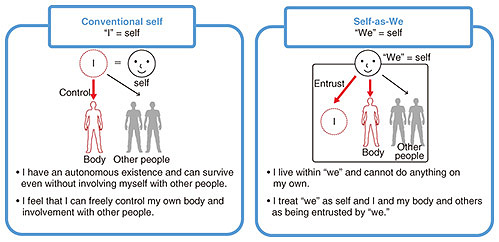 |
|||||||||||||||
|
|
|||||||||||||||
|
Feature Articles: Research and Development toward a Well-being Society Vol. 20, No. 10, pp. 37–43, Oct. 2022. https://doi.org/10.53829/ntr202210fa5 Human Information Science Research for Understanding and Improving Our Well-beingAbstractOur well-being takes on a variety of forms—it can be shaped by many factors such as an individual’s physical and mental states, values, and even relationships with other people. We would like to contribute to improving people’s well-being by comprehensively grasping such diverse forms of well-being, understanding the human information processing mechanisms lying in the background, and devising intervention methods to act upon those mechanisms. This article introduces our ongoing research on understanding and achieving well-being based on human emotions. Keywords: emotion, mindfulness meditation, measurement of well-being 1. People’s well-being and human information science researchAt Human Information Science Laboratory in NTT Communication Science Laboratories, we aim to develop information and communication technologies that enable heart-to-heart communication. Thus, we are researching information processing mechanisms involved in perception, cognition, action, and emotion, focusing on the human brain and body from the three viewpoints of information science, psychology, and neuroscience. In everyday life, we feel the world around us through our eyes, ears, nose, tongue, and skin, i.e., our sensory organs, and move our bodies and act upon the world accordingly. Through this interface that we call the human body, we can engage in heart-to-heart communication by accepting another person as he or she actually is and touching that person’s heart. Emotions are essential in heart-to-heart communication yet difficult to control as one would like. When receiving the hearts of others, emotions include things that appear unconsciously as a physical reaction (emotional reaction), which, in turn, includes things that one is aware of and recognizes (emotional cognition = feelings). These interact with each other and greatly shape our perceptual experiences and behavior in daily life. These emotions are deeply involved with our well-being, which is a vibrant state that we can vividly feel. They constitute a subjective experience that incorporates an emotional reaction that arises when we receive information from the environment or from another person, and within that, emotional cognition that we can be actively conscious of. In other words, well-being is something that is greatly affected by a transition in emotions. For this reason, it is thought that understanding the mechanisms of human emotions and handling them appropriately can help improve well-being. 2. Research into mindfulness meditation as an emotion control method for regulating physical and mental statesEmotions that change from day to day can enrich our lives at times and make us suffer other times. Coping effectively with these fluctuating emotions and being in a vibrant state is the basis of individual well-being. However, in modern everyday life, full of stress brought on by a rapidly changing environment, information overload, interaction with many people, etc., achieving well-being is not so simple. Under these conditions, mindfulness meditation has been attracting attention. Today, an increasing number of companies are introducing meditation as a method for reducing employee stress and improving focus and productivity. Some schools are also adopting it as a method for reducing stress in children and helping them manage their feelings. This, as well as the development of many types of meditation apps, reflect the rapid adoption of meditation in society. Against this background, we are researching the physiological, psychological, and neural mechanisms triggered by the practice of mindfulness meditation with the aim of improving the well-being of people by establishing new intervention methods based on scientific knowledge. 3. Physiological basis of stress-reduction effects caused by mindfulness meditationThe awareness that arises from paying attention in the present moment, and non-judgmentally is called mindfulness. Mindfulness meditation, which seeks to achieve this state, is a form of mental training that begins by focusing one’s attention on a single target, such as one’s breath, then gradually expanding to various senses, feelings, and thoughts. The aim is to control one’s attention and emotions without being swayed or confused by those targets of attention. Many studies have shown that this form of meditation can effectively reduce stress, prevent recurrences of depression, and improve well-being. The physiological mechanisms behind this reduction in stress by mindfulness meditation have remained unclear. Autonomic activity and concentrations of stress hormones have been used as indicators for measuring stress, but the effects of mindfulness meditation on these physiological indicators have been inconsistent. Therefore, we looked at mindfulness meditation as a combination of two meditation methods: focused attention meditation for focusing one’s attention on a single target and open monitoring meditation for recognizing various senses, feelings, and thoughts as they are [1] (Fig. 1). We hypothesize that the effects of either one or the other meditation method was presented or the effects of both was presented in mixed form in previous studies, which suggests that inconsistencies would likely appear among those results.
We developed a 30-minute period of instruction for both focused attention meditation and open monitoring meditation that would enable even people with no experience in meditation to practice each method. We then investigated changes in participants’ physiological stress levels caused by focused attention meditation and open monitoring meditation. The results indicate that focused attention meditation triggered a rise in parasympathetic activity, the physiological basis of relaxing (Fig. 2(a)). Open monitoring meditation, however, started an increase in sympathetic activity, the physiological basis of arousal (Fig. 2(b)), and a simultaneous drop in cortisol level, which is said to be a stress index (Fig. 2(c)). These results can be interpreted to mean that focused attention meditation has the potential of ridding oneself of distracting thoughts and enabling relaxation by focusing on a single target. During open monitoring meditation, in contrast, people’s arousal level is high because they experience various senses, feelings, and thoughts, whereas their stress is reduced because they experience them as they are (Fig. 2(d)). Therefore, it has been shown that focused attention meditation and open monitoring meditation activate different physiological mechanisms and contribute to stress reduction in different ways [2].
By effectively combining focused attention meditation and open monitoring meditation, the possibility arises of improving our well-being on our own by appropriately controlling our inner state as in making changes to autonomic activity, hormone levels, etc. 4. Measuring diverse factors in everyone’s well-beingOur well-being takes on diverse forms—it is not determined solely on the basis of an individual’s physical and emotional states. It can also change according to what a person values and how that person understands his or her relationships with other people, the environment, etc. In short, a multifaceted approach must be taken to obtain a deeper understanding of well-being. With this in mind, we are devising original techniques for measuring (1) changes in self-reported physical and mental states, (2) values that need to be satisfied for oneself, and (3) the way in which people perceive the relationships with others (idea of self), and testing the validity of each of these techniques. 4.1 Intuitive and embodied experience-sampling method for monitoring physical and mental state transitionsEmotions have aspects of physical emotional reactions and subjective emotional cognition, so to learn about the inner state of an individual, it is necessary to measure changes in that person’s subjective mental state in addition to objective biological indicators such as hormone levels and autonomic nerve activity. One technique for evaluating subjective physical and mental states is the experience-sampling method. This method is a research procedure for monitoring ever-changing subjective emotions, thoughts, feelings, behaviors, etc., with respect to a particular event at that instant or shortly after. This self-reporting is performed several times a day, so a method that makes for easy and intuitive replies is desirable. Therefore, we decided to use sound symbolic words and interjections in Japanese, which can be considered subjective expressions with embodied intuitions [3]. This method records one’s emotions at a certain moment several times a day using such words, e.g., “doki-doki,” used in a sense similar to the English “thump-thump,” and interjections such as “waai” used in a sense similar to the English “wow,” which makes it possible to examine transitions in subjective mental state with a minimal cognitive load on the user (Fig. 3(a)). On actually using this method to investigate the relationship between daily changes in mental state and well-being (16 subjects × 4-week survey), and taking as an example a day that participants thought of as “a really good day” (high well-being), we found that there were many replies such as “uki-uki (うきうき)” indicating good expectations of the future or “iki-iki (いきいき)” and “niko-niko (にこにこ)” reflecting a positive state compared with replies like “yosshaa (よっしゃあ)” indicating instantaneous joy (Fig. 3(b)).
4.2 Tools for visualization and sharing valuesThings that are important to ones or mentally satisfy oneself differ from person to person. The first step toward respecting and achieving diverse forms of well-being is to remind oneself of one’s values and notice similarities and differences between these values and those held by surrounding people, thereby fostering mutual understanding. We conducted a questionnaire-based survey targeting about 1300 people asking them to write down three things “important to you” and categorized the approximately 3900 replies obtained (Fig. 4(a)). We found that we could categorize those replies into things concerning oneself (I), things concerning involvement with other people (We), things concerning involvement with the community and society (Society), and things concerning the world, nature, and other broad subjects (Universe) [4]. We then extracted main factors from those four categories and created 27 “Our Well-being Cards” (Fig. 4(b)) [5]. These cards can be used as a tool for promoting awareness of what values one and surrounding people hold.
We have used these cards in a workshop targeting elementary school students. Groups of students shared what was important to each in terms of well-being then devised a travel plan that could achieve well-being for all members of the group. The students commented that “I was surprised that some things were the same as those of other students while other things were different” and that “The story of a trip can grow infinitely when other people are present.” We found that such an activity could promote mutual recognition of diverse values. 4.3 Measurement of holistic idea of self—Self-as-WeIt has been pointed out that how one perceives oneself in relation to others, that is, one’s idea of self, differs according to culture and the individual. In collaborative research with Professor Yasuo Deguchi, a philosopher at Kyoto University, we developed the Self-as-We scale to quantitatively evaluate the Self-as-We concept proposed by Professor Deguchi on the basis of a technique in psychology for measuring personal characteristics [6]. The conventional idea of self is that “I” myself can exist in an autonomous manner since I can manipulate tools and control my environment even without having to interact with other people. However, Self-as-We views “we” consisting of everything such as other people and the environment as “self” and considers “I,” as a member of “we,” to be entrusted by “we” for some of the same actions as other people and things (Fig. 5). In other words, people and things within “we” can be viewed as equals deserving of respect. The Self-as-We scale quantifies such involvement with the environment and other people through a multi-item questionnaire.
On surveying the relationship between mental health and the idea of self during the COVID-19 pandemic using the Self-as-We scale, we found that people who were more strongly inclined to have a Self-as-We view were less likely to be depressed, that is, they were in better mental health [7]. 5. ConclusionTo contribute to improving our well-being, it is necessary to understand the underlying mechanisms of human emotions and understand and act upon diverse forms of well-being comprehensively. Going forward, we will continue to research human information science to understand and improve people’s well-being from various viewpoints including psychology, neuroscience, information science, philosophy, and design. References
|
|||||||||||||||


















